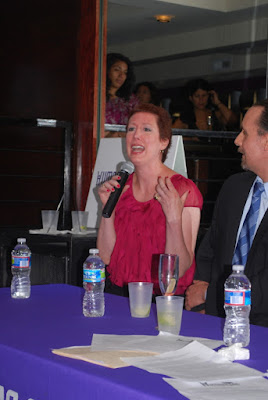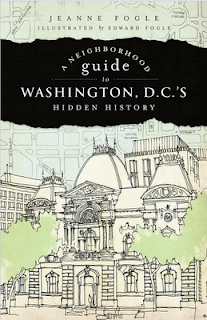Check out all the great projects that will be on display this year...
Preserving LeDroit Park: An Historical Community in Washington, DC
This documentary film, produced by Ronald Smokey Stevens, explores the history of the LeDroit Park neighborhood from its beginnings as an exclusive, all-white subdivision through its transformation into the bastion of Washington's black middle class. The film highlights eminent residents of LeDroit Park who made significant contributions to DC and the nation.
Panel Exhibition on the Reopening of Peirce Mill
The iconic Peirce Mill is located in Rock Creek Park between the Cleveland Park and Mt. Pleasant neighborhoods in northwest Washington. For years, the site has served as physical link between Washington's urban present and agrarian past. To help reacquaint Washingtonians with this historic landmark after a 12 year $3 million renovation, Friends of Peirce Mill has produced four large exhibit panels which will be moved to display sites throughout the city.
Washington Color School Project
The Washington Color School is an art movement centered on a loose association of painters active in the DC area active since the 1960s. The project participants seek to create an online archive of interviews and other materials relevant to the history of the Washington Color School. The organization also held an illustrated talk by eminent art critic Paul Richard who has witnessed the growth and change of the DC art community since the rise of the Color School.
Exterior and Interior Graphic Panels and Video about Historic Adas Israel Synagogue
The Historic Adas Israel Synagogue is the Jewish Historical Society of Greater Washington's most unique and valuable artifact. In 1969, the Society even moved the entire building to its present location to save it from demolition. Despite its importance to the cultural and architectural history of Washington, DC, it has featured no interpretive interior displays before now. As the culmination of a series of DC Community Heritage Project Grants, the Society has produced an indoor panel and an outdoor panel to help bring the history of the Adas Israel Synagogue to life.
Ivy City Neighborhood and Oral History Project Film
The DC Community Heritage Project has supported Empower DC for the past several years in their efforts to document and disseminate the history of the Ivy City neighborhood. The results have been outstanding and include: over 20 oral history interviews; research and collection of historic photos and memorabilia; an hour-long radio-quality documentary about the community; and a full color, 30 page publication based on the oral histories. Taking their project to the next logical step, Empower DC has created a documentary film to further tell the story of Ivy City.
John Eaton Elementary School Centennial Website
Cleveland Park's John Eaton Elementary School has been a fixture in the community for 100 years, and a group of ambitious fourth graders have taken it upon themselves to research their school's past and document it on the internet. The students have been to the Sumner School to learn research skills, the National Building Museum to learn museum skills, and the Library of Congress to learn how to conduct oral history interviews. The results will be posted on a specially redesigned centennial version of the school's website.
My DC Neighborhood in 1955
The Essential Theatre company produced and documented a panel discussion to coincide with their production of, "A Rose Among Thorns," a tribute to Rosa Parks. The panel was filled by DC residents who lived in various neighborhoods during Parks' iconic demonstration on a Montgomery, Alabama bus in 1955. The panelists discussed their feelings on the event, and how it began to change their neighborhoods as the Civil Rights Movement shifted to center stage in America's socio-political consciousness.
The Museum of the Caribbean Diaspora: A Digital Repository
This ambitious project, headed by Roger Caruth and The Institute of Caribbean Studies, seeks to digitally document the history and culture of the Washington, DC Caribbean Diaspora making artifacts such as oral histories, photographs, and primary source documents available online as a database and as curated exhibits. The project makes use of the George Mason University Roy Rosenzweig Center for History and New Media's open-source Omeka museum collections software.
DC Authors' Houses: a Web Exhibit
This project is where literary history and architectural history meet. The team representing a coalition of four DC humanities non-profits have researched and photographed the historic homes of some of Washington, DC's most eminent writers including: Frederick Douglass, Zora Neale Hurston, and Sinclair Lewis. The fruits of this labor will be available to the public in the form of a professionally designed, easy-to-use web exhibit which will allow the group to continue adding new research well beyond the end of their current grant.
Voices on Fourteenth Street: Columbia Heights in the Sixties
Scholar Bell Clement and her sponsoring organization, Public Communications, Inc., have launched an oral history project to document work done by members of the Columbia Heights community to redefine their neighborhood and the terms of its governance for themselves. The project is part of a larger effort to explore American urban policy and changes in the conception of the American city during the 1960s. Five narrators were chosen through contacts with neighborhood and religious organizations, and Clement prepared a synthesis of the interviews interpreted with archival research.
Historic Woodlawn Cemetery Records Conversion Project
Tyrone General has worked tirelessly to preserve and popularize the history of Woodlawn Historic Cemetery, and last year he received a DC Community Heritage Project grant to create several large interpretive banners to spread the story of the cemetery and the historic figures buried there. This year, in response to increased inquiries from genealogists and other researchers, General has initiated an effort to digitize the cemetery's detailed yet unwieldy paper archives.
The African-American Pioneer Muslimahs in Washington, DC
During the middle of the 20th century many African-American women in Washington, DC withstood challenges from their families and communities as they converted to a religion then seen as quite foreign and unusual. These women banded together and created a strong community of their own as they worked to create a new way of life for their children. This project documented the stories of some of the oldest Muslimahs in DC for a video set to premiere soon at a public screening.
The Anacostia Heritage Ride
The Anacostia Bicyclist Association developed this dynamic tour of select neighborhoods on the African American Heritage Trail to demonstrate cycling’s ability to contribute to the popularization of DC’s rich history and culture. Riders were provided with bicycles, water, snacks, and a companion guide developed by the ABA to help bring the heritage of Old Anacostia, Hillsdale, and the Waterfront neighborhoods to life.
Fotocraft Camera Club: More than Seven Decades of Photography in the Nation’s Capital
The Fotocraft Camera Club began at the 12th Street YMCA in 1937, and quickly established itself as the District’s premiere photography organization for African Americans. When the 12th Street YMCA closed its doors in 1982, Fotocraft persevered, moving to the 19th Street Baptist Church where members continue to meet twice per month. To celebrate their club’s storied past, Fotocraft initiated this oral history project to preserve the memories of its long-time members which will be interpreted in the context of the history of Washington, DC, and of the iconic 12th Street YMCA.
Uncovering a Piece of Capitol Hill History through stories of the Capitol Hill Arts Workshop
The Capitol Hill Arts Workshop has provided classes, performances, lectures, and exhibits to the Washington, DC community for nearly 40 years. This year, they inaugurated an oral history project to preserve the memories of the individuals whose lives they’ve touched. As the interviews are completed, Project Director Peter DiMuro will analyze them and create an interpretive brochure.
Third Annual Historic Church Tour of Deanwood
This architectural and cultural tour of Deanwood’s churches aims to engage and educate audiences about the heritage of some of the most iconic buildings in the neighborhood. Though the history of these buildings is not widely known outside of Deanwood, the memories and stories they represent are an important part of the city’s past. Deanwood Heights Mainstreets publishes a spectacular booklet that highlights and interprets each of the tour stops.
Living Images in My World: A History Beneath Us - Forgotten Sacred Ground Across the River Creek
Last Summer, "I Saw! The Experience of Learning in DC Project" took students from the Columbia Heights Youth on a journey through time, combining historic research with material culture and anthropological studies. The students visited The Mt. Zion Church Female Union Band Cemetery, and conducted research at libraries and archives throughout the city in an attempt to reconstruct the lives of six African Americans who cannot be found in their history textbooks. The students then produced a blog, a documentary film, and a booklet with a full bibliography.
What's In a Name: Profiles of the Trailblazers, History and Heritage of District of Columbia Public and Public Charter Schools
This project is a continuation of Women of the Dove's efforts to document the history of DC's Public and Public Charter schools. The organization has produced a booklet, and a CD highlighting their research on 86 schools, and this most recent grant has allowed them to document an additional 75 schools.
 Stevens' film exemplifies the value of historic preservation and public history. It not only tells the story of LeDroit Park, but it tells the story of a man who's regular rounds through the neighborhood carried him past the Robert and Mary Church Terrell House, and how these encounters with the past inspired and empowered him to find out more.
Stevens' film exemplifies the value of historic preservation and public history. It not only tells the story of LeDroit Park, but it tells the story of a man who's regular rounds through the neighborhood carried him past the Robert and Mary Church Terrell House, and how these encounters with the past inspired and empowered him to find out more.


























